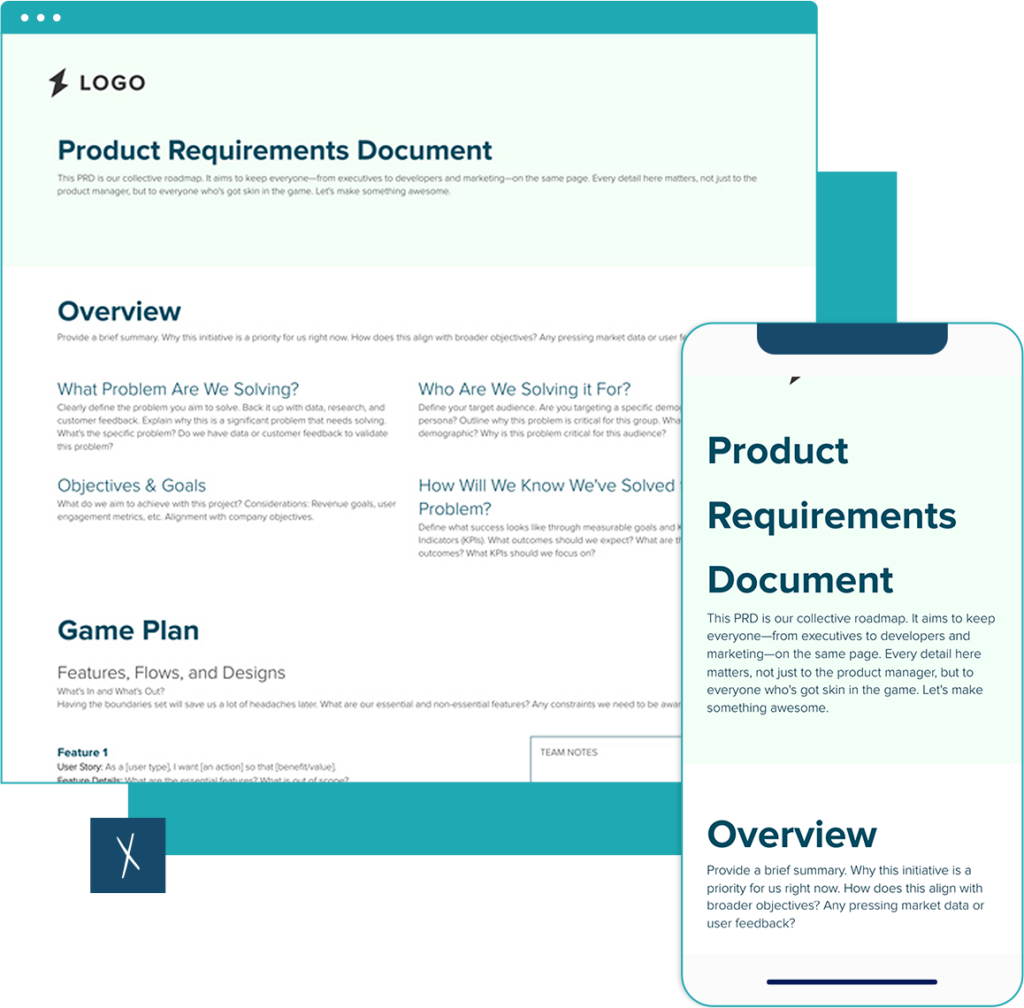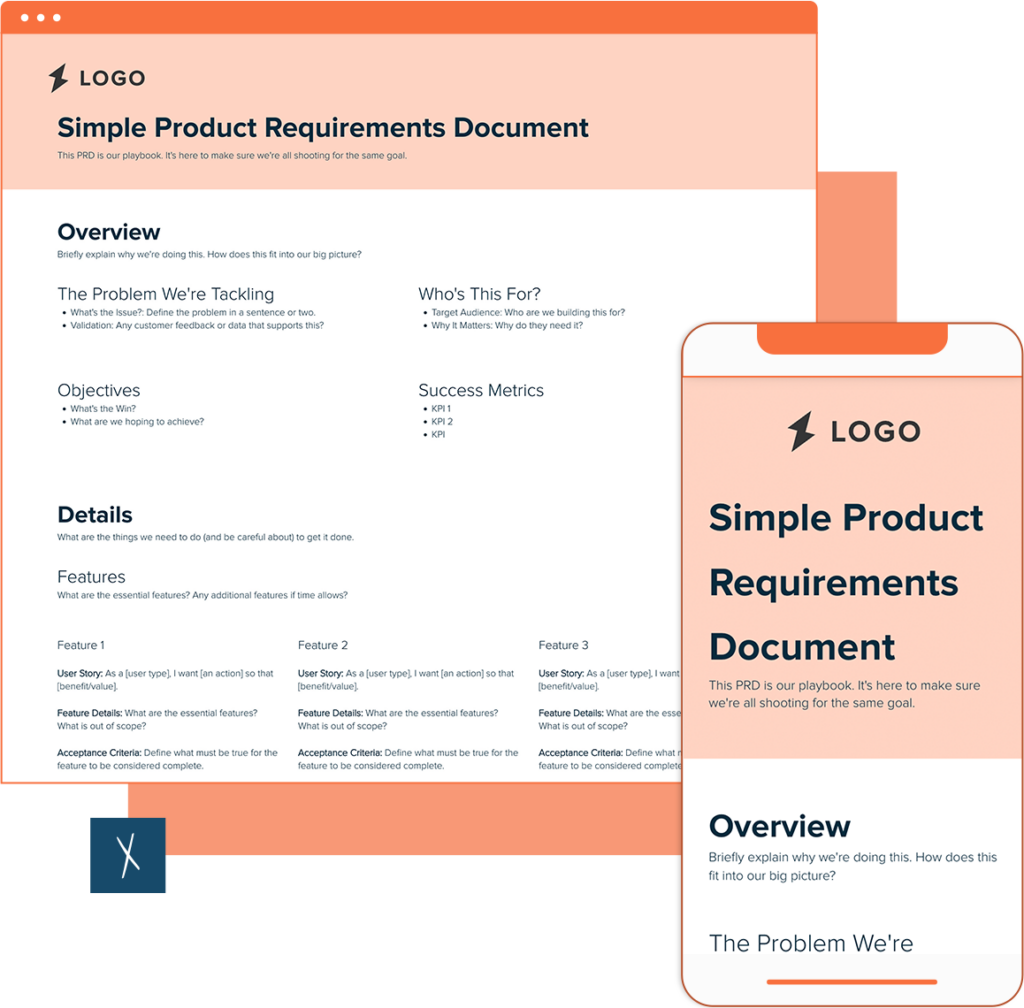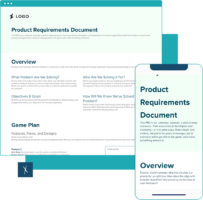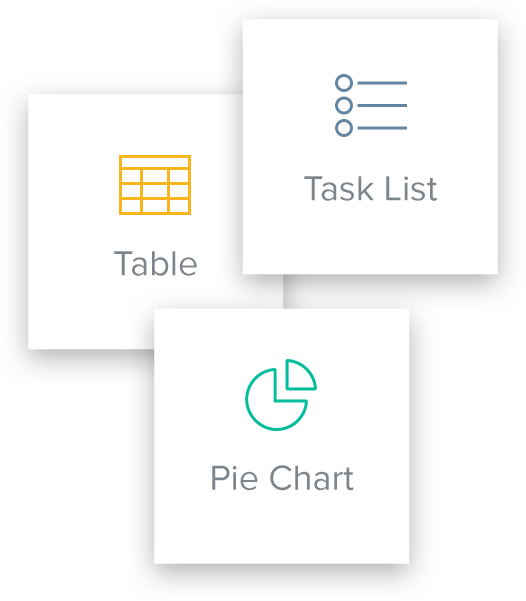How To Create a Product Requirements Document (Comprehensive Guide with Template)
Creating a Product Requirements Document (PRD) is more than just a procedural step in the product development journey. It’s a pivotal venture that sets the tone for the entire project. The essence of a PRD lies in its ability to encapsulate the vision of stakeholders while providing a clear, actionable roadmap for the development team. This guide aims to provide you with a structured approach to crafting a comprehensive PRD, spotlighting the unique features of Xtensio as a platform to streamline this process.
Take a look at our examples and follow along with our free template.
Xtensio is your team space for beautiful living documents.
Create, manage and share business collateral, easily.
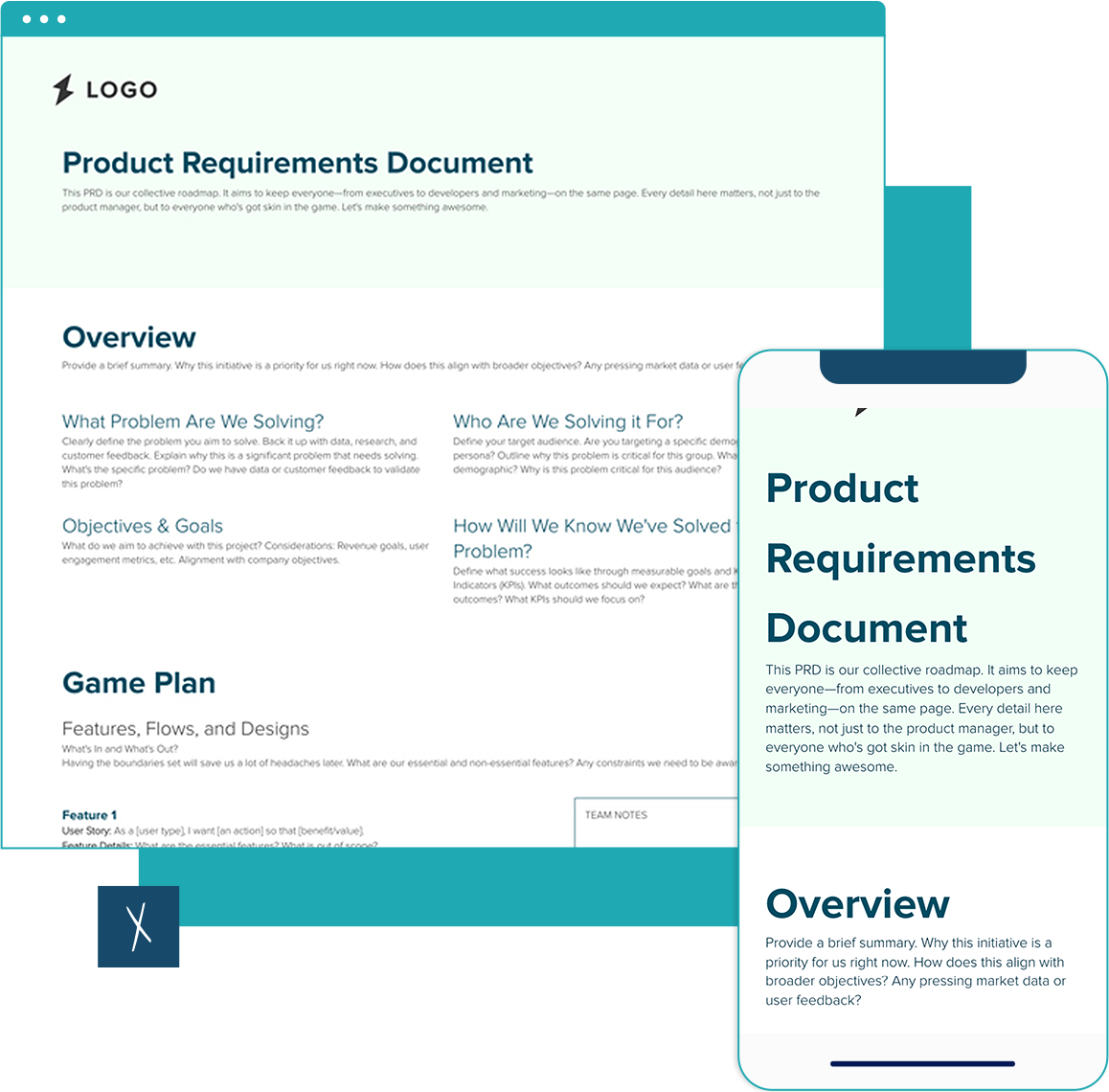
Table of Contents
The Basics of a Product Requirements Document
Definition and Importance
A Product Requirements Document (PRD) is a detailed document that delineates the features, goals, and attributes of a product, thus serving as a blueprint for its development. The vitality of a PRD is underscored by its role as a contract between the business and development teams, ensuring everyone shares the same vision from the outset1. A well-prepared PRD is akin to a well-oiled machine, facilitating smoother transitions through the development phases, and averting potential misunderstandings that could derail the project.
Components of a PRD
A robust PRD is an amalgam of several components, each serving a distinct purpose in articulating the product’s essence and requirements:
- Product Overview: A high-level snapshot of the product, encapsulating its core essence.
- Goals and Objectives: The raison d’être of the product, articulated clearly.
- Functional and Non-Functional Requirements: The heart and soul of the PRD, detailing what the product should do and how it should behave.
- Constraints and Assumptions: Any limitations or assumptions made during the product development, crucial for mitigating risks.
Preparing to Draft Your PRD
Understanding Your Product
Before you dive into drafting your PRD, having a lucid understanding of your product, its target audience, and the problems it aims to solve is paramount. This understanding serves as the bedrock upon which the rest of the PRD is built.
Check out Xtensio’s FREE Strategy Templates here
Gathering Necessary Information
Embarking on the journey of drafting your PRD necessitates a treasure trove of information. Market research, competitor analysis, and stakeholder interviews are the compasses that guide the drafting process. Tools like surveys and analytics platforms can morph into invaluable allies in this quest for information.
Creating a Comprehensive Product Requirements Document: A Section-by-Section Guide
How To Create a Product Requirements Document: Overview
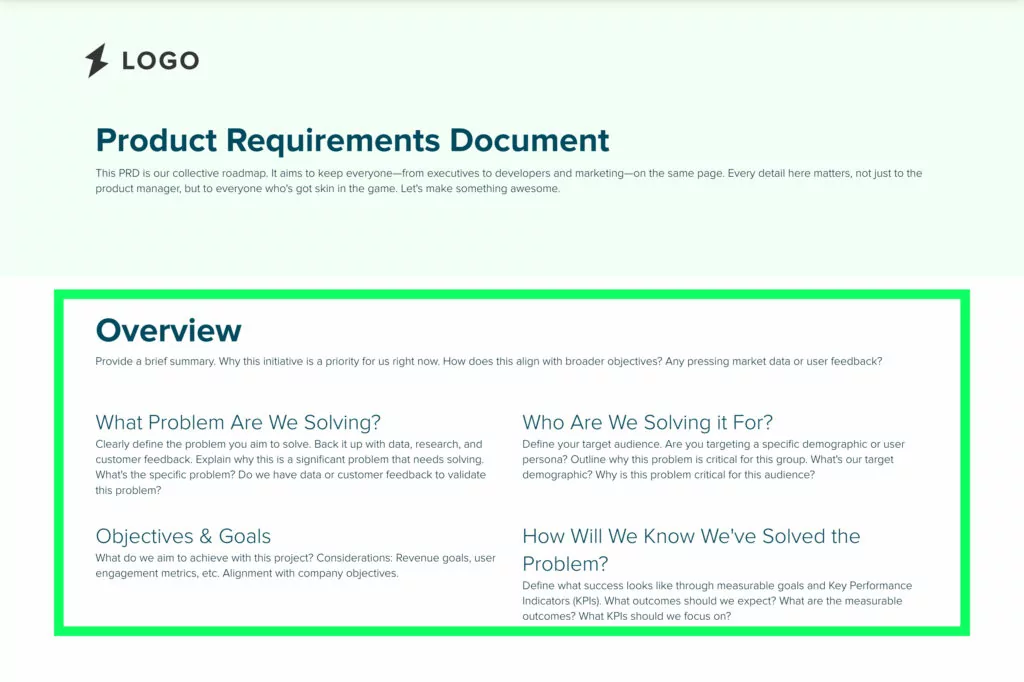
What Problem Are We Solving?
- Clearly articulate the core issue or challenge your product aims to address.
- Tip: Employ user feedback, market research, or statistical data to substantiate the problem statement. It’s not just about stating the problem but validating its existence.
Who Are We Solving it For?
- Describe your target audience or user personas in detail.
- Tip: Engage in user research, create detailed personas, and ensure every stakeholder has a clear understanding of the users’ needs and pain points.
How To Create a Product Requirements Document: Objectives & Goals
How Will We Know We’ve Solved the Problem?
- Define success metrics, Key Performance Indicators (KPIs), and the benchmarks that will indicate the problem has been resolved.
- Tip: Set SMART (Specific, Measurable, Achievable, Relevant, Time-bound) objectives to ensure clear, actionable, and time-oriented goals.
How To Create a Product Requirements Document: Game Plan
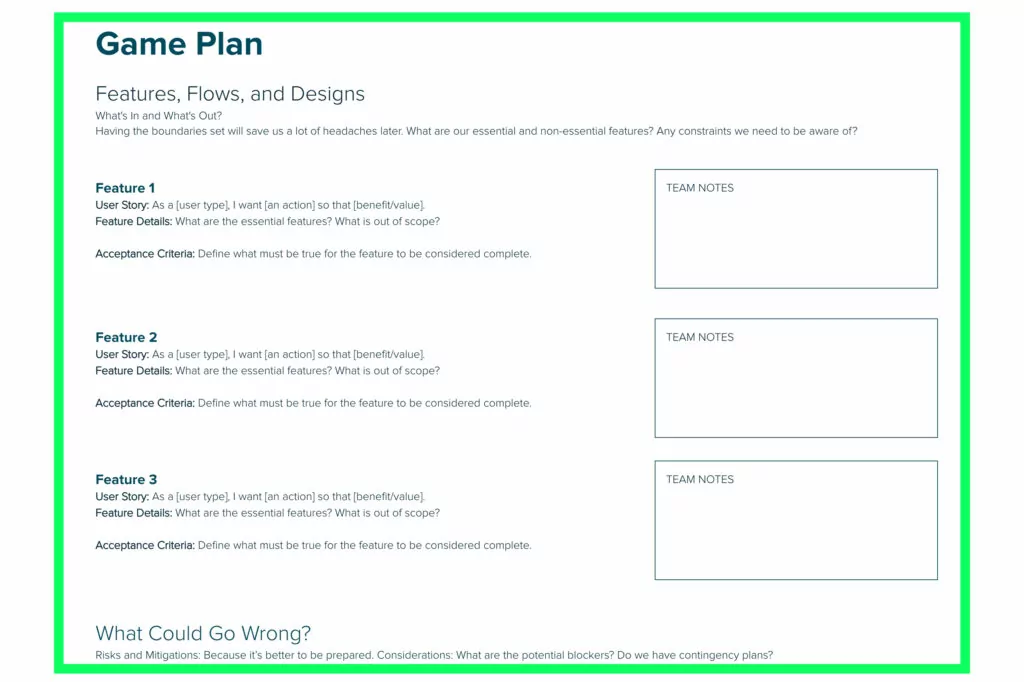
Feature, User Story
- Craft a narrative from the user’s perspective describing their interaction with this feature.
- Tip: Adopt a simple, clear language. Employ the formula: “As a [type of user], I want [an action] so that [a benefit/a goal]”.
Feature Details
- Delve into the functionality, interactions, and design of the feature.
- Tip: Include wireframes, mockups, or diagrams to provide visual context.
Acceptance Criteria
- Enumerate the conditions that the feature must satisfy to be accepted.
- Tip: Draft clear, concise, and testable criteria. Each criterion should be verifiable.
TEAM NOTES
- Record any pivotal information, insights or feedback from the team.
- Tip: Encourage open communication and document all relevant discussions.
How To Create a Product Requirements Document: Features, Flows, and Designs
What’s In and What’s Out?
- Define the scope by detailing included and excluded features.
- Tip: A well-articulated scope helps to prevent feature creep and keeps the project on track.
What Could Go Wrong?
- Identify potential risks, challenges, and uncertainties.
- Tip: Conduct a risk assessment, encourage team members to share their concerns and anticipate common hurdles.
Risks and Mitigations
- Propose strategies to mitigate identified risks.
- Tip: Develop contingency plans, allocate resources for risk mitigation, and ensure everyone is aware of the action plans.
Considerations
- Note any legal, ethical, or technical factors that could impact the project.
- Tip: Engage with experts or consultants to ensure all considerations are well-understood and addressed.
When’s Showtime?
- Set the timeline, milestones, and deadlines for the project.
- Tip: Utilize project management tools to visualize the timeline and track progress against milestones.
Tasks
Itemize the tasks necessary to achieve your objectives, delegating responsibilities, and setting deadlines.
How To Create a Product Requirements Document: Launch
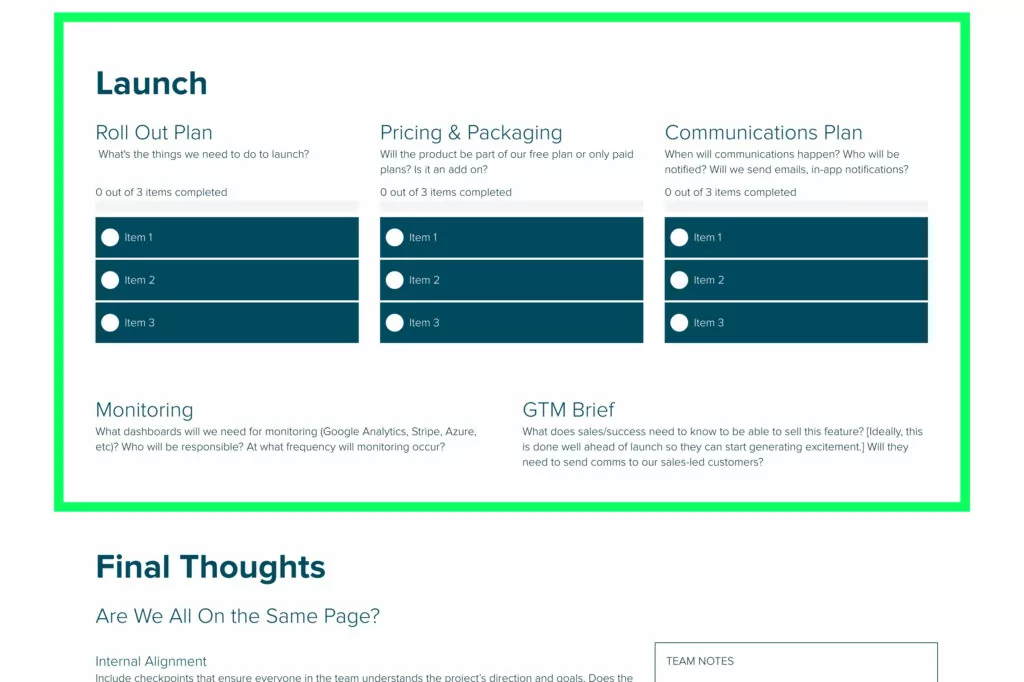
GTM Brief
- Draft a robust Go-To-Market (GTM) strategy outlining the product’s journey from development to market.
- Tip: Align your GTM strategy with your objectives, ensuring it’s geared towards reaching your target audience effectively.
Monitoring
Develop a comprehensive monitoring plan to track performance, user engagement, and other relevant metrics post-launch.
Roll Out Plan
Detail the phases of your product rollout, identifying key milestones, metrics for success, and a contingency plan for any unforeseen challenges.
Communications Plan
Draft a communications plan to ensure effective and timely communication with stakeholders, team members, and the user community throughout the project.
Pricing & Packaging
Delve into the pricing strategy and packaging options for your product, ensuring they align with the market expectations and your business objectives.
External Communication
Devise an external communication strategy covering press releases, social media, and other channels to promote your product and engage with the external audience.
How To Create a Product Requirements Document: Final Thoughts
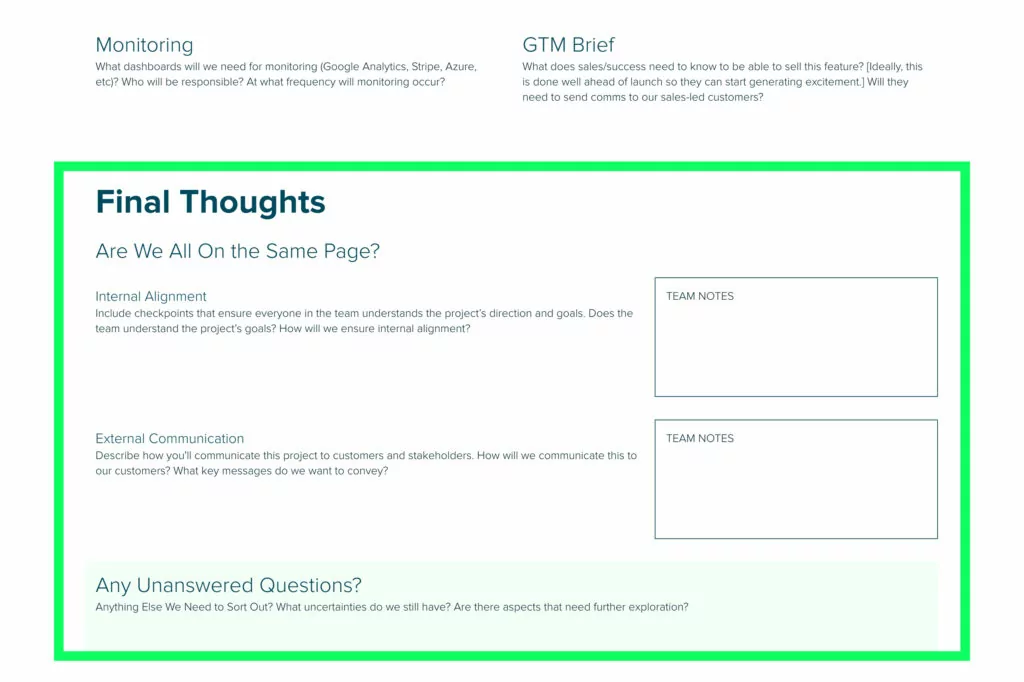
Any Unanswered Questions?
List any remaining uncertainties, unknowns, or open questions and propose a plan to address them.
List of free sources used in this article
Certainly! Here’s the final list of resources formatted with the title of the article linked to the article:
- Managing the Product Requirements Definition Process – PMI
- Product Requirements Specification Process in Product Development – ResearchGate (Note: Access to the full document may require a ResearchGate account or institutional access.)
- SMART Goals – Xtensio
- MoSCoW Prioritisation – Agile Business Consortium
- Xtensio: Collaborative Platform for PRD Creation – Xtensio
- User Stories – Atlassian
- What is a Product Roadmap? – ProductPlan
Frequently Asked Questions
What is the role of user stories in a PRD?
User stories help to center the development process around the end-user’s needs and experiences. They provide a simple, clear narrative focused on delivering value to the user, which can guide feature development and design decisions.
How do I prioritize features in my PRD?
Prioritizing features can be done using various frameworks like MoSCoW (Must have, Should have, Could have, Won’t have) or scoring methods like Weighted Scoring. Engage with stakeholders to determine the priority based on business value, user needs, and technical feasibility.
Can a PRD evolve over time?
Yes, a PRD can and should evolve over time to reflect new insights, feedback, and changes in project scope or objectives. It’s essential to maintain a living document that can be updated as necessary throughout the development process.
How does a PRD contribute to project scope management?
A PRD helps in defining and controlling what is included and what is not in the project. By clearly outlining features, objectives, and acceptance criteria, it provides a baseline that helps in managing scope creep and ensuring the project stays on track.
What is the difference between a PRD and a roadmap?
A PRD is a detailed document focusing on a specific product’s features, goals, and requirements for a particular development cycle, while a roadmap provides a higher-level, strategic overview of the product’s direction over a longer term.
How do I handle feedback and revisions in my PRD?
Utilize collaborative platforms like Xtensio to gather feedback, make revisions, and keep all stakeholders updated on changes to the PRD. Establish a feedback loop with key stakeholders to ensure the document remains accurate and aligned with project goals.
What are some common pitfalls to avoid when creating a PRD?
Common pitfalls include vague language, lack of stakeholder involvement, failure to prioritize features, inadequate detailing of acceptance criteria, and not updating the PRD based on feedback or changes in project scope.
How can I ensure that my PRD is aligned with my Go-to-Market strategy?
Engage with marketing and sales teams when drafting your PRD to ensure alignment. Ensure that the features and objectives outlined in the PRD support the goals and tactics laid out in your Go-to-Market strategy.
What is the role of acceptance criteria in a PRD?
Acceptance criteria provide clear, specific conditions that a feature or product must meet to be considered complete. They help in setting the right expectations and provide a basis for acceptance testing.e of acceptance criteria in a PRD?
How can I measure the success of my PRD?
Success can be measured by how well the final product aligns with the objectives and requirements outlined in the PRD, and how effectively it solves the identified problem for the targeted users. Utilize metrics and KPIs defined in the PRD to evaluate success.
